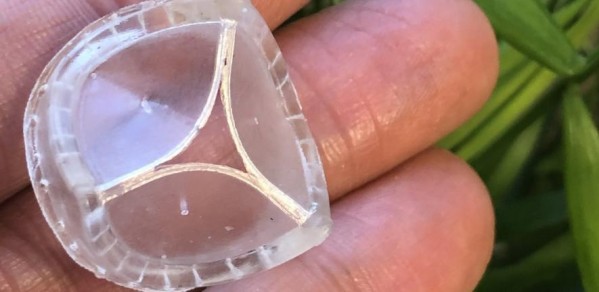
A new type of artificial heart valve, made of long-lived polymers, could mean that millions of patients with diseased heart valves will no longer require lifelong blood-thinning medication after valve replacement surgery.
These impressive results show the PoliValve is a promising alternative for valve replacement surgery.
Professor Geoff Moggridge
The valve, called PoliValve, has been developed by scientists at the Universities of Cambridge and Bristol. The team’s latest in vitro results, published in the journal Biomaterials Science, suggest that the PoliValve can last for up to 25 years in patients, far longer than other types of replacement heart valves. In addition, a small pilot study in sheep showed that the valve is highly compatible with biological tissue. The researchers anticipate that the PoliValve can be tested in humans within five years.
More than 1.3 million patients with diseased heart valves need valve replacement globally each year. There are two types of artificial valves currently available, however both have limitations either in durability or in biocompatibility.
Biological valves are made from pig or cow tissue and have good biocompatibility, meaning patients do not need lifelong blood-thinning medication; however, they only last 10-12 years before failing. And mechanical valves, while they have good durability, have poor biocompatibility and patients must take daily blood-thinning drugs to prevent blood clots.
Professor Geoff Moggridge from the University of Cambridge and Professor Raimondo Ascione from the University of Bristol have spent three years conducting developmental work and testing on the PoliValve, supported by funding from the British Heart Foundation.
The device is made from a special co-polymer and is designed to resemble a natural heart valve. It was created by Professor Moggridge, Dr Marta Serrani and Dr Joanna Stasiak at Cambridge and Professor Ascione in Bristol, and builds on earlier work by Professor Maria Laura Costantino’s group at the University of Milan.
The PoliValve combines excellent durability with biocompatibility, addressing the limitations of current biological and mechanical artificial valves. It is made through a simple moulding process, which also sharply reduces manufacturing and quality control costs.
“These impressive results show the PoliValve is a promising alternative for valve replacement surgery,” said Professor Moggridge, who leads the Structural Materials Group at Cambridge’s Department of Chemical Engineering and Biotechnology. “While further testing is needed, we think it could make a major difference to the hundreds of thousands of patients who get valve replacement surgery every year.”
According to ISO standards, a new artificial heart valve must withstand a minimum of 200 million repetitions of opening and closing during laboratory testing, equivalent to five years of life span, before it can be tested in humans. The new Cambridge-Bristol polymeric valve has comfortably surpassed this.
Initial testing in sheep has been undertaken at Bristol’s Translational Biomedical Research Centre (TBRC) facility as a first step to ensure safety. Long-term testing in sheep, also funded by the British Heart Foundation, will be carried out before bringing this new treatment to human patients.
“Patients requiring an artificial heart valve are often faced with the dilemma of choosing between a metallic or tissue valve replacement,” said Professor Sir Nilesh Samani, Medical Director at the British Heart Foundation. “A metallic valve is long-lasting but requires the patient to take lifelong blood-thinning drugs. Although this medication prevents clots forming on the valve, it also increases the risk of serious bleeding. Patients who have a tissue valve replacement usually don’t need to take this medication. However, the valve is less durable and means the patient may face further surgery.
“The polymer valve combines the benefits of both – it is durable and would not require the need for blood-thinning drugs. While further testing is needed before this valve can be used in patients, this is a promising development, and the BHF is pleased to have supported this research.”
The PoliValve has also exceeded the requirements of ISO standards for hydrodynamic testing, showing a functional performance comparable to the best-in-class biological valve currently available on the market. The small pilot study in sheep demonstrated the device is easy to stitch in, and showed no mechanical failure, no trans-valvular regurgitation, low trans-valvular gradients, and good biocompatibility with tissue.
“The transformational PoliValve results from an advanced Bristol/Cambridge-based biomedical cross-fertilisation between experts in biomaterials, computational modelling, advanced preclinical development/testing and clinical academics understanding the patient needs. The new valve could help millions of people worldwide and we aim to test in patients within the next five years,” said Professor Ascione.
The British Heart Foundation-funded study also included Dr James Taylor from Cambridge’s Whittle Laboratory, a team at Newcastle University headed by Professor Zaman, Professor Saadeh Sulaiman at University of Bristol and Professor Costantino’s group at Politecnico di Milano.
Dr Taylor assisted in the manufacture of the prosthetic heart valves. He used a computer numerical control (CNC) milling machine based at the Whittle Laboratory to create the metal moulds for the valve. This is the same machinery that Dr Taylor and his colleagues regularly use to make turbine blades for experiments on aircraft engines.
"The moulds we made were more accurate and done in a tenth of the time at a tenth of the cost than those bought from outside companies before we started the collaboration. This means we've now been able to test over 20 different designs, understand what is going on and come up with one that meets the ISO standard. I also helped out a little with the fluid dynamics and mechanical design," he said.

Examples of the metal moulds for the PoliValve manufactured by Dr James Taylor in the Whittle Laboratory. Credit: Dr James Taylor.
Reference:
Joanna R. Stasiak et al. “Design, Development, Testing at ISO standards and in-vivo feasibility study of a novel Polymeric Heart Valve Prosthesis.” Biomaterials Science (2020). DOI: 10.1039/D0BM00412J
Adapted from a University of Bristol press release.

